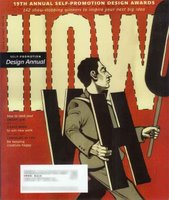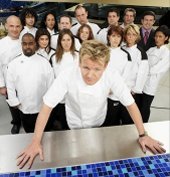 It's Been an Exciting Trip, y'all
It's Been an Exciting Trip, y'allIn the beginning, back in June, they were twelve, and one by one they fell off: Polly. Gabe. Larry. Giacomo. Tom. Then Rachel, Maribel, and at last, Keith.
And then it was down to dark horse Virginia, and strong player Heather.
Tonight's 2-hour finalé was all-new. Typical of the 2-hour block was a rerun of last week's epi followed by the new epi. This one did not retelecast Keith's Last Stand; rather, a 10-minute block up at the front of the program recounted a few remarkable seconds of each contestant in the order of elimination.
Then it was the kickass opening titles.
Then, Captain Obvious: "And, now, the conclusion of Hell's Kitchen".
Long Lost Loved OnesAfter the elimination of Keith, Heather and Virginia retire to the dorm. They are both wound tighter than a cheap watch, and can't believe they've gotten to be the finalists.
And, whilst celebrating thier victory, an unexpected surprise; Virginia's mother and husband, and Heather's parents.
This is why HK is good TV, and when it's good it's deadly; they know how to tug on the heartstrings. The reunion was a tearjerker for sure, and it was sweet to watch both contestants reconnect and tell what had happened to them thus far. The reunion was as brief as it was sweet, and it was bedtime for the finalists.
Meet the PressThe very first thing next day, Heather and Virginia were tersely summoned to the kitchen by Chef Ramsay. What they found, to thier surprise, was a fully locked and loaded press conference, ready to have at them.
The remarkable part of this was watching the two women, who, save HK, were never TV personalities, handle the press. The questions (the ones we saw anyway) weren't terribly challenging, but the moment to remember was when Heather and Virginia got out front of the podium to do thier happy dance. It was hilarious...and just a little bit embarrassing for Heather. But if they could stand up to the Ramdog, they could cope with this.
It was announced then, with the flourish of a drapery, that the restaurant was to be divided in two, so that each chef could decorate her side and come up with a restaurant experience of thier own.
For one, shining night, both were to have thier own restaurant. The successful one-night-restauranteur was to be the winner.
Two Visions, One SpaceHeather went with a young, video-visioned space that served family-style fare, and Virginia went with a sumptuous, cozy space that aspired to luxury. They met with the Red Rock architect and the actual designer of Hell's Kitchen to define thier visions and set them loose. The two head-chefs-for-a-night went at it with gusto and obvious heart...
...but, said Chef Ramsay, there's a bit of business to take care of first. Off to Vegas with you both.
The Last ChallengeThe destination, a casino in Vegas, was to be the site of the last showdown. This promised to be interesting, with the determined Heather (who hadn't won a challenge despite her obvious skill) against the charmed Virginia (who, despite her bad luck in the kitchen, had won more challenges than anyone else). The task: an on-the fly taste test of each's signature: Virginia, the chicken roulade, and Heather, the fish and cauliflower pureé.
Twenty passersby, twenty taste tests, twenty votes. It was tight all the way; Virginia and Heather are by now very accomplished cooks. And, at the end of it all (with Virginia deploying her patented full-frontal flirting (hey, don't hate, now...she's good at it)), the two were level-pegging.
One last taster, hemming and hawing, interrupted by a commercial break...gave the challenge to Virginia. I tell you, that lady's good!
Before returning to L.A., however, they had one more surprise. Each was given a ticket to come visit London, and dine in Chef Ramsay's own signature restaurant when they could. No matter who won, they're getting a great trip out of this.
Back Into HellUpon returning to Hell's Kitchen, they find the remodeling well underway. And Chef Ramsay has another little surprise for them: thier kitchen staffs. Returning to Hell, we found: Keith, Garrett, Tom, Giacomo, Rachel, and Omarosa...er, Sara.
They then began to choose staffs. The winner of the Vegas challenge got the first go; Virginia, somewhat surprisingly, chose Keith. Heather, rather expectedly, chose Rachel. Virginia then selected Tom, Heather took Sara, Virginia selected Giacomo, which left Garrett to go with Heather.
It was then time to break and go get the teams in shape. Heather came out strong, with a team who looked like they wanted her to win; it was quite amazing to see even Garrett with a great positive attitude. Heather knows how to motivate.
Virginia...well, hmm. Let's just say she needs a bit of polish. She wasted little time in saying that she intentionally went for the weakest links, which went over about as well as one might think it did. We think her idea was to show what she could do with the dead-enders, while giving them a chance to be on a winning team.
Keith once again showed what his "slammin" version of class was by demanding money for performace. He'd guaranteed her that he would give his best in return for money. Tom and Giacomo didn't look very good during this exchange either; eventually, Virginia relented and promised each one $1,000 which, considering the prize in the balance, is actually getting off easy.
Troubles In ParadisesThis was about midway through the day of the evening in which each Chef's respective restaurants were to open. Many problems cropped up during construction (which must have been round-the-clock) and each were taken care of in thier turn, portraying management skills on the fly, and leaving us to wonder whether or not, like the mid-service delivery three weeks back, they were 'programmed' in to test the chef's mettle.
Regardless, the remodels proceeded while the head chefs set up thier menus and coordinated thier brigades. The redesign problems faced by Heather were farily mild and were handled with easily identified alternatives, but Virginia's special effect–a 'waterfall wall'–looked abortive until a mere 20 minutes before opening.
But they were solved, the menus planned (with input from Chef Ramsay, who opined that there couldn't be two more different menus) and servers and staff ready. Let 'em in.
The Great Wall of DiningThe diners entered and began ordering; the kitchens fired up under the direction of thier respective head chefs, with Ramsay looking on. One thing they weren't told; the president of the Red Rocks resort was there to sample from both menus, and his input was to have great influence over Chef's choice of the winner.
While each kitchen had thier ups and downs, in all, Heather was solid from one end to the other. She bossed her crew with resolve, excercised excellent quality control, and prevented the kitchen from going off into the weeds.
Virginia's was more error prone. When Tom cut his finger, things started to look grim. Before that, Virginia's obsession with perfection caused her to take posession of plating
everything, and they were getting buried. Also, her weak links, while better than before, were still weak, and it kind of showed. Ramsay abused Tom for being a prima donna over his finger cut–which really wasn't all that bad, we've suffered worse–and had to almost harangue Virginia into delegating some help from Keith at the pass. Once that was done, however, the service picked up, and Virginia closed the gap. Unfortunately, in Virginia's haste to get ahead, she was sending out poor-quality entreés by the end–including a fish filét that was all but swimming in oil.
Both finished strong in the desserts, and there was a very entertaining sequence where Heather had to ride Sara about obvious mistakes in plating her desserts.
The Ride is Almost OverEnd of service. Both teams gathered in the kitchen, given high praise by Chef Ramsay, and complimentary yet vague insight by President Red Rock, giving both dishes he tried high marks but seeming to favor neither.
The teams dismissed. Heather and Virginia return to the dorm to await Chef Ramsay's decision.
You Have Two Doors. Behind One Of them Is Living The Dream...Eventually summoned upstairs by Ramsay, both women find themselves before two doors. Chef explains that he's come to his decision influenced by customer comment cards and the input of Prez Red Rock. He gives them respect and admiration for weathering the course, and a job well done.
He issues both chefs a door key, one for each locked door; the winners door will open. On the count of three...One...Two...
...Commercial break...aneyurism...back from break....
One...Two...Three...go.
Heather steps through. The room below, filled with diners, guests, and the other contestants, erupt in cheers. From behind the door, we can see Chef Ramsay embrace Virginia in consolation, but, even here at the Station, there isn't a dry eye in the house.
We had a feeling it would be Heather all along. From that first time she delegated her station in Week 2, when she burned her hand, we had a feeling she had the right stuff. And we all who followed Heather were right. She's a 25-year old chef who got the chance to show that she wanted the summit so bad, and took that and ran with it.
We won't feel too sorry for Virginia, however. No, she didn't win The Prize, but she won our respect, and we think that someone with her palate and design skills shouldn't have much trouble finding some sort of success.
But only one could win, our new hero, Heather West.
Chef Ramsay Gets The Last Word"I'm looking forward to my next challenge...and f*** you all!", as he gives us a hearty laugh as he goes into the sunset.
Ready For Another Helping?Various sources have reported that Hell's Kitchen has been picked up for a 3rd series, ETA next year about the same time.
Though we'll have to, we can't wait. But we will.
Technorati Tags: Hell's Kitchen, Gordon Ramsay, Heather West










